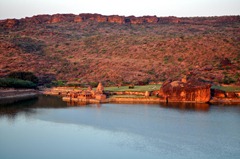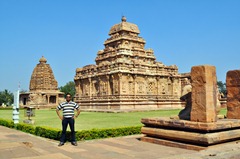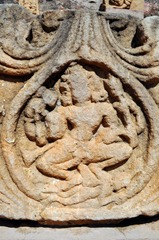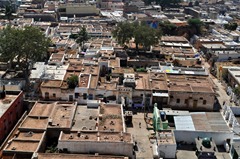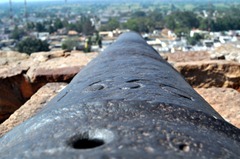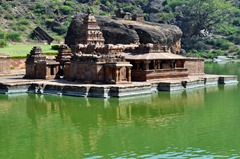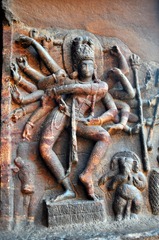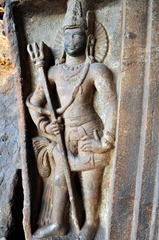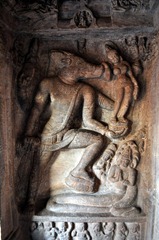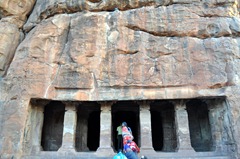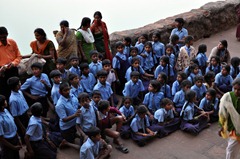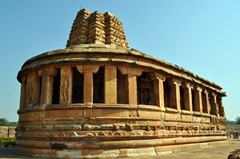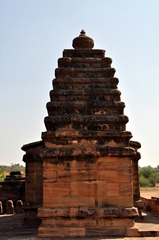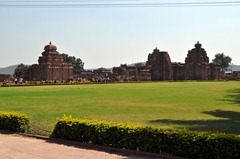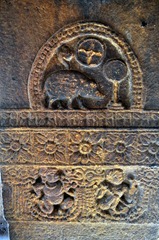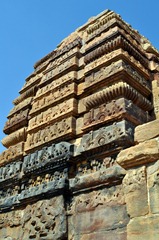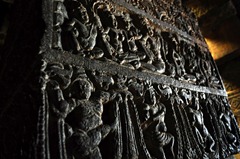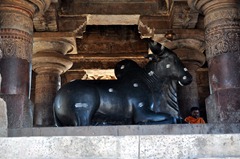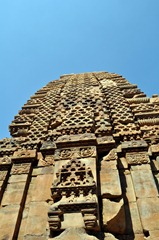After a long time, I’ve found some time to write about another archaeological marvel in Karnataka. As you already know from the title of the post, it is the Badami-Aihole-Pattadakal circuit.
Being a budget traveller, I would like to minimize my cost but at the same time would like to maximize my experience level at any given destination. I was accompanied by my cousin Arun. He is fascinated by the history and architecture of India. He loves to visit the sites and learn more about them.
History :
BADAMI
Badami was the capital of the Chalukyan dynasty, the dynasty that has made its presence in the southern and central India between 6th and 12th century. The early Chalukyan dynasty was known as “Badami Chalukyas” as they had their capital at Badami. Pulakesi II was the ruler during this time. The rise of this empire saw the birth of efficient administration, overseas trade. The most important development was the new style of architecture called "Chalukyan architecture".
Kannada literature, which had enjoyed royal support in the 9th century found eager patronage from the Western Chalukyas in the Jain and Veerashaiva traditions. The 11th century saw the birth of Telugu literature under the patronage of the Eastern Chalukyas.
Badami was founded in 540 A.D. by Pulakeshi I. His sons Krithivarman and brother Mangalesha I constructed the renown cave temples at Badami. The greatest ruler among the Chalukyas was Pulakeshi II who had defeated many kings, except had faced a defeat against the Pallavas in Kanchipuram (Tamil Nadu).
The rock-cut Badami cave temples were sculpted between the 6th and the 8th century. The four cave temples represent the secular nature of the rulers then, with tolerance and a religious following that inclines towards Hinduism, Buddhism and Jainism. Cave 1 is devoted to Lord Shiva, Caves 2 and 3 are dedicated to Lord Vishnu, whereas cave 4 displays reliefs of Jain Theerthankaras.
Deep caverns with carved images of the various incarnations of Hindu gods are strewn across the area, under boulders and in the red sandstone. From an architectural and archaeological perspective, they provide critical evidence of the early styles and stages of the southern Indian architecture.
AIHOLE
Early inscriptions call this town Āryapura. According to mythology Aihole is the place where Parashurama washed his axe after killing the killing of the Kshatriyas. Aihole has historical significance and is called as “The Cradle of Hindu Architecture”.
Aihole was the first capital of the early Chalukyas. Here they built over 125 temples in various styles and it is believed to be a laboratory of experiments in rock cut architecture. Pulakesi I, one of the greatest rulers of this dynasty, moved the capital to Badami nearby. Badami was then known as Vatapi. It is from these temples that the Chalukyas gained their experience and went on to build the great temples of Pattadakal.
PATTADAKAL
Pattadakal (place for Chalukyas crowning ceremony), the capital of the Chalukya dynasty of Southern India, who built the temples in the seventh and eighth centuries. There are ten temples including a Jain sanctuary surrounded by numerous small shrines and plinths. Four temples were built in Dravidian style, four in Nagara style of Northern India and the Papanatha temple in mixed style. At Pattadakal, the Chalukyan kings were crowned, in the middle of the 7th century, temple building activity shifted from Badami to Pattadakal.
What to see:
At Badami:-
1) Cave Temples – accessible from the main bus stand by walk or by auto-rickshaw.
2) Agastya Lake
3) Bhoothanatha Temple
4) Archeological Society of India Museum
At Aihole:-
Group of monuments
At Pattadakal:
Group of monuments
TRAVELLER’S NOTE: While going from Badami to either Aihole or Pattadakal, do visit the Banashankari temple.
Our journey – detailed
There are several trains from Bangalore which reach Badami. These trains start from Yeshwantpur railway station. The frequent trains running are:
06535 Bijapur Express (Tue, Wed, Fri, Sun)
16535 Solapur Express (Mon, Thu, Sat)
The sleeper class fare from Bangalore to Badami is Rs.244 for an adult passenger. The trains depart Yeshwantpur at 19:45 and arrive the next day in Badami at 07:33.
There are several hotels around the bus stand at Badami. We chose to stay at Hotel Rajasangam International. We got ourselves a standard non-AC room for Rs.800 per day. Check-in at 11:00 and check-out is at 12:00 the next day. There was nothing international about the hotel though the hotel name brags about it. So, I suggest any traveller not to expect too much out of it. There are AC rooms also available. It is better to book the hotel in advance. If you want a star accommodation, then narrow your choice down to Badami Court. They are pricey, but most of the foreigners choose to stay here cause of the facilities and ambience.
Once we reached Badami, we took an auto to the hotel. We checked in, had our shower and set out. We had our breakfast at the restaurant attached to the hotel. NOT GOOD. Definitely not a match for Bangalore’s fast food centres. We then decided to walk to the caves as advised by the hotel personnel. It was hardly a 2km walk. We managed to reach there and visit the ASI Museum. We then took a walk around the Agasthya lake. It was a hot day. Visited the small sites around the ASI Museum. The heat had us walking slow and we had not slept well in the train. So, we decided to head back to our room and it was time for our lunch too.
One thing me and my cousin loved in Badami was the local food eat-outs called “Khanavalis”. These are like mess. They serve lunch and dinner which has the culinary specialities of the North Karnataka – Jolada Rotti and Enagai (Corn Rotis and brinjal gravy) along with chutney powder, onions and some curd. Also with this you get rice served, with pappad, a curry and some pickle. Yummy!!! They are not that costly and they are good for health.
After our siesta, we decided to cover the cave temples during the evening time. We decided to take a rick to the caves. Once we reached there, we saw a massive crowd of school children from more than 5 schools who had come to visit the caves. Lot of commotion. I hate crowded places, but had to live up to it. Life is full of surprises. We visited the caves and watched the red ball of fire set in the West. The auto driver who we had hired was enquiring with us if we wanted to visit Aihole-Banashankari-Pattadakal the next day. We were not sure if we wanted to go by bus or by a rick.
After a lot of discussion about the pros and cons, we decided to hire the rick for the next day’s sight seeing. He quoted Rs.600 for the entire day, we bargained it, but succeeded to bringing it down to Rs.550 only. After having our dinner we retired for the day. Next day we left early, for two reasons. One, is to avoid the heat, and two is to avoid the school crowd as far as possible.
We visited the Banashankari temple first, which is 5km from Badami town, enroute Aihole. Once we finished our darshan, we had our breakfast at a hotel near the temple. Again, not up to the mark. We then headed to Pattadakal, finished our sightseeing there and on our way back, we visited Aihole. We decided not to hire a guide as we felt it was going to be a sure shot cheating attempt by any unregistered guide.
We were amazed by the architectural details but I was not satisfied. I felt Hampi to be more exciting and explore-worthy than this circuit. My cousin had his own reasons to justify they were different experience. I could not disagree. We had our train booked for the next day from Badami back to Bangalore. The same trains run to and fro. Our train was scheduled to depart at 20:00 and reach Bangalore the next day at 09:15.
For those who can spend more time can travel from Badami to Bijapur, visit the sites there and take the direct train from Bijapur to Bangalore. There are trains and buses to Bijapur and it is a 3 hours journey.
Until my next post, Bonne Journee!
